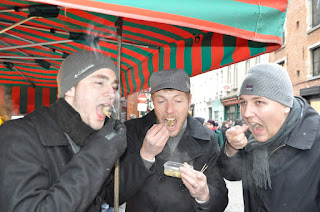 | |||
| (L to R) Me, Josh, Mike eating escargot at the Mannequin Pis in Brussels, Belgium. |
When my family got orders overseas to Germany, we let our lease run out on our house and stayed with Josh and his wonderful family (Erin "The Instigator" Carroll and his daughter, Sweet Jadyn) for about a month. This month was filled with Josh and I experimenting on the grill with sauces, random meats and random recipes. As a result H.E.B. stock values rose significantly, and I learned a few things.
- You can grill anything.
- Wives do not appreciate ginormous grocery bills on a nightly basis.
- It's not all about the food. It's about the people, the community and friendships you create and nurture while creating and eating good food.
Grilled Zucchini
Recipe by Josh Carroll
I cut 4-5 zucchinis into thin (1/8 - 1/4 inch) round slices on a moderate bias. I've done long strips, and they cook much easier and quicker but they always get floppy, so I prefer them chip style. Then I place them into a gallon-sized freezer bag with the following ingredients:
- 1/2 a lemon's juice
- 1 tbspn or so of white wine vinegar (lately I've been using a bottle that's infused with basil)
- 1 1/2 tbspns or so of paprika
- 2 cloves of garlic, pressed
- 1 tbspn dried Italian herbs
- Salt and pepper to taste
- Just enough good olive oil to cover everything

Then I squish and shake the baggie until all the zucchini is evenly coated and let it marinate on the counter for 20-30 mins while I prep whatever main course we're having, flipping the baggie a couple times. I suppose I could marinate in a bowl, but I like the baggie because I can see all the food, it's easier to keep some of the slices from getting soaked at the bottom, there's no clean-up, and I like the way it feels to squish everything around.
When it's time to cook, I place all the slices in a single layer on a grill sheet with small grates (foil with holes poked in it would work too, so long as the juices and oil can't pool), and put it on a hot grill. It usually takes two rounds to cook it all because it takes up so much real estate. And this is where I get really anal about this: Until I can rig up a thin, secure grill basket that will hold all these tiny pieces well enough and keep them close to the fire, I have to flip each slice individually. And I do. It's involved, but when I get it right, it's totally worth it. The idea is to let each side just start to blister before pulling, about 4 mins per side over medium-high. If you wait too long, they'll burn, but when they're just past golden, they're prefect. And you can't achieve that golden crisp texture unless both sides get grill time.
 When I'm making these
just for myself, I like to toss the finished chips in a small amount of
the leftover marinade and some salt, but most people think that makes
them too intense, so I usually just pull them and serve them hot off the
grill.
When I'm making these
just for myself, I like to toss the finished chips in a small amount of
the leftover marinade and some salt, but most people think that makes
them too intense, so I usually just pull them and serve them hot off the
grill.I've made this recipe with garlic powder or bacon salt instead of fresh garlic, I've used all lemon instead of vinegar, and I've used balsamic and brown sugar. They're all good. Some red pepper or parmesan would be good too. I'll have to try that next time. Also, I don't recommend cooking this over wood or really smokey charcoal. In fact, I only do it on a gas grill. It soaks up excessive smoke flavor waaaaay too easily.
Josh, thank you so much for sharing your recipe. I am forever indebted to you and your amazing family. Not just for the food, obviously, but for the love, mentorship, fellowship and being one heck-of-an uncle to my little turd kids.







